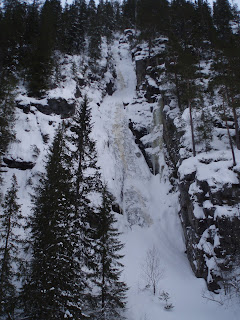
The aim of last week was for the friluftsliv class to spend 3 days ski-touring, over nighting in snow holes. The chosen site for the snow holes was a steep sided stream bed, with a lee slope and a windward slope. My group of four chose to dig our hole on the windward slope which also caught the sun for most of the day. The rest of the class decided to dig into the lee slope where there was deeper snow. The spot was fairly sheltered from a constant 25 mph wind

Around 3pm the next day the lee slope avalanched partially filling the 3 holes that had been dug there. Luckily nobody was hurt despite 1 girl being carried a short distance and fully buried in the slide and 3 or 4 others who were covered to their waists. After digging out all the buried sleeping bags, cooking kit and clothing we binned the trip and headed back to Levanger. It seems the moral of the story is not to dig your planned snow hole into a lee slope that is being loaded by wind transported snow, spend some time finding a safer location instead.

As a result of some snafu’d communication I have just had a week without lectures instead of joining classmates at a ski school in Dombas. All is not lost as I can join another group of students next week. Instead I have been giving blood in spectacular fashion.



On Thursday whilst top-roping a steep and thin ice pillar with Gudmund I got hit in the face by a large chunk of ice. I had swung my right axe into the top of a bulge and was watching it to see the quality of the placement as you do. A chunk of ice literally exploded out of the bulge and caught me just under my nose. I spluttered with surprise and shock and liberally coated the ice in front of me with blood. My mouth had become an air brush, loaded with bright red paint. I assumed that I only had a nose bleed, so sprayed my way up the rest of the pillar and set up another top rope over another route. Gudmund climbed this while I belayed with a wad of snow stuffed into my nose. Rest, Snow, Compress, Elevate.

When we got back to the car my face was still dyeing chunks of snow a bright red. So I had a look in the mirror and decided a trip to the hospital was probably a good idea. 2 stitches later I was set free to wander home, feeling like I had been facing Amir Khan for 5 rounds.

Warm days and cold nights are a recipe for disaster if you travel by bike. The route to join friends for dessert, whiskey and cards went via a steepish downhill. An icy steepish downhill. As the back wheel slid away from under me I knew I was going too fast to get a foot down and a trip down the road on my backside was inevitable. And painful. No stitches this time, but I will need to take the bits of road out of my arm soon and put them back before the council complains. My heartfelt thanks to Gudmund and Kirsten for helping me plug holes in my body twice in 2 days and especially for the effective top quality liquid analgesics, matured for 10 years in oak casks in a misty land far away.
























